| |
|
|
|
|
|
|
|
|
|
|
|
| |
| |
 |
|
| |
田润德
编译
文/图 2020-06-29 19:36 |
|
| |
|
|
|
|
| |
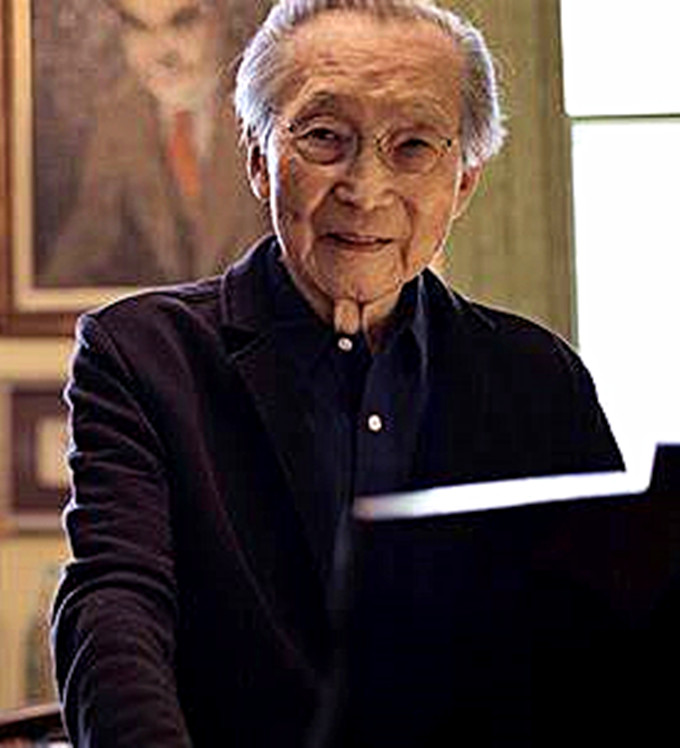 |
|
|
|
| |
周文中(Chou Wen-chung 1923-2019) |
|
|
|
| |
|
|
|
|
| |
“郑明勋演绎周文中与布鲁克纳”国家大剧院管弦乐团音乐会
|
|
|
|
| |
2016年4月,国家大剧院第五届“中国交响乐之春”顺利拉开帷幕。汇聚了来自全国不同省市的12支交响劲旅,以及12位驰名中外的指挥大师与诸多杰出的演奏家,在动人乐声中,带领观众一同追溯中国交响乐的流金记忆。4月29日,国家大剧院管弦乐团在指挥郑明勋的带领下上演了周文中《花月正春风》和布鲁克纳《E大调第七号交响曲》两部中外作品,第五届交响乐之春至此圆满闭幕。 |
|
|
|
| |
In April 2016, the National
Center for the Performing Arts kicked off the fifth "Chinese Symphonic
Spring".It brings together 12 symphony orchestras from different
provinces and cities in China, as well as 12 world-famous conductor
masters and many outstanding performers. In the moving music, it leads
the audience to trace the golden memory of Chinese symphony together.On
April 29, under the leadership of conductor Zheng Mingxun, the Orchestra
of The National Centre for the Performing Arts performed two Chinese and
foreign works, Namely Zhou Wenzhong's "Flower Moon Is in the Spring" and
Bruckner's "Symphony No. 7 in E Major", thus successfully concluding the
fifth Symphonic Spring. |
|
|
|
| |
|
|
|
|
| |
音乐历史上的今天
1923年6月29日,出色的作曲家周文中生于中国烟台。
周文中(Chou Wen-chung
1923年6月29日-2019年10月25日),华裔美国作曲家。祖籍江苏常州,生于山东烟台。1946年广西大学毕业赴美国,入新英格兰音乐学院学习作曲。1949年入哥伦比亚大学,学习音乐学和作曲,
1954年取得音乐硕士学位,1958年入美国籍。
周文忠先生是世界著名作曲家、美国文学艺术院终身院士、哥伦比亚大学艺术学院副院长及作曲博士研究所的主任。 [2]
主要作品包括:《山水》、《花月正春风》、《花落知多少》、《思凡》、《行草》、《渔歌》、《变》、《谷鹰》、《山涛》、《浮云》等。
北京时间2019年10月25日夜,周文中先生在美国家中去世,享年96岁。
周文中(Chou Wen-chung
)早年在上海读书多去美国前巳获得过本工程学位。赴美后,起初在耶鲁大学继续攻读建筑学,但是,后来他决定献身音乐,从而转入新英格兰音乐学院(England
ConserVatory of Musie),随尼古拉斯·斯洛宁斯基(Nicolas
Slonimgky)学作曲。周文中也曾在纽约跟埃德加·伐累斯(Edg ar Varese)学习过。其后又在哥伦比亚大学随奥托·吕宁(0tto
Luening)学习,并在l954年于该校获得音乐硕士学位。1955-1957年周文中在哥伦比亚大学指导中国古典音乐的研究项目,现任该校文学院音乐系主任。他曾数次得到荣誉奖,他的音乐为欧洲、美洲和东方的主要乐团所演奏,他积极地从事于写作与讲演,他是他的老师与友人埃德加·伐累斯在后期的文艺见解的履行者。周文中的早期作品以中国的传统音乐与民歌为基础,但是根据他自己所说,这些因素仅是能后来音乐作品中的起点而已。周文中虽然在他的音乐中使用当代的西方手法,可是,他在色彩与结构方面的精深细致却是别具一格,引入注目。
周文中在自己的文章中,强调这样一个事实:最近许多西方音乐家开始集中注意于作为东方传统的一些特定的音质。一个音里面显著可见的音质也有好几种,可是早期的西方作曲家却很少着眼于此,他们大体上都是纠缠于对位“声部”的相互作用,更近一些的,则是纠缠于乐队的“色彩”问题。
上面所说的音质,包含对每个音的精雕细琢,提供对每个音的大量的演奏方法,当一个音延续的时候,使音的强度、音高,甚至音色起落变化,然后再奏完这个音。这种详尽的研究方法看来象是一种微型研究法,可是一当这种方法在周文中的音乐中得以体现时,它便产生了一种新的创作方法。
今日视频:1、“郑明勋演绎周文中与布鲁克纳”国家大剧院管弦乐团音乐会;2、瓦雷兹《乐团调音》完成周文中(巴斯克国家管弦乐团);3、周文中《变》,为钢琴、十件木管和四位打击乐而作;4、纪录片:周文中
:音乐的汇流 。
|
|
|
|
| |
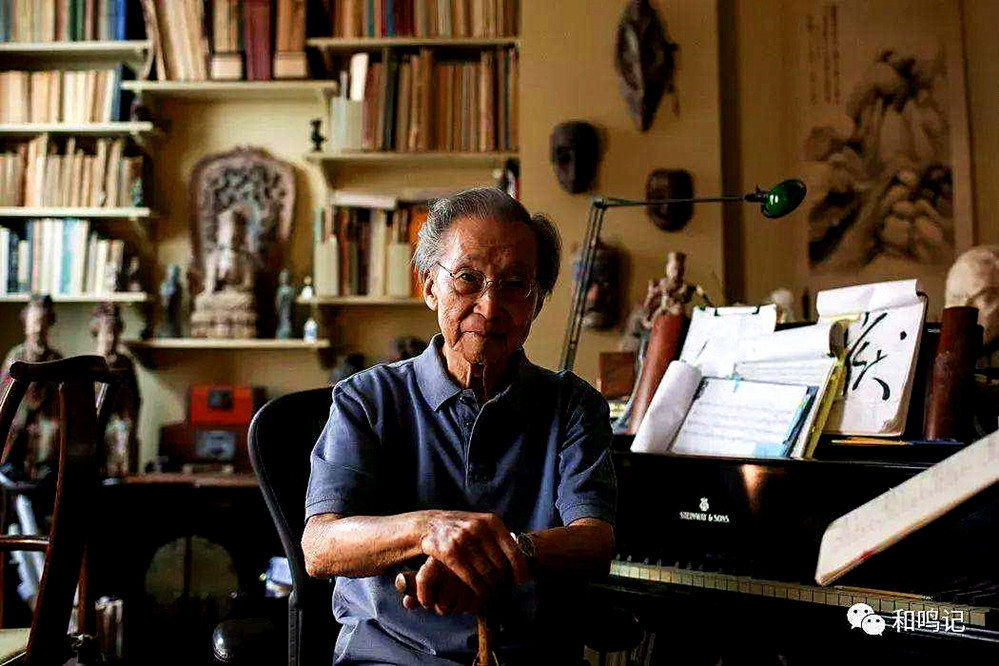 |
|
| |
周文中(Chou Wen-chung 1923-2019) |
|
|
|
| |
Today in the
history of music
Outstanding composer Zhou Wenzhong was born in Yantai, China on June 29,
1923.
Chou Wen-Chung (June 29, 1923 -- October 25, 2019) was a Chinese
American composer.He was born in Yantai, Shandong province.In 1946, he
graduated from Guangxi University and went to America to study
composition at the New England Conservatory of Music.He studied music
and composition at Columbia University in 1949, received his Master's
degree in music in 1954, and was naturalized in the United States in
1958.
Mr. Zhou wenzhong is a world-renowned composer, a lifelong fellow of the
American Academy of Literary and Art, vice President of the School of
The Arts at Columbia University and director of the Institute for The
Doctor of Composition.[2] His major works include: Landscape, Flower
moon is in the Spring, How many Flowers fall, Thinking, Walking Grass,
Fishing Song, Change, Eagle in the Valley, Mountain Tao, Floating
Clouds, etc.
On the night of October 25, 2019 Beijing time, Mr. Zhou Wenzhong passed
away at the age of 96 at his home in the United States.
Chou Wen-Chung earned an engineering degree in his early years as a
student in Shanghai, mostly in the U.S.After moving to the United
States, he at first went on to study architecture at Yale, but then
decided to devote himself to music, switching to the England
ConserVatory of Musie, where he studied composition with Nicolas
Slonimgky.Mr. Zhou also studied with Edg Ar Varese in New York.He then
studied with 0tto Luening at Columbia University, where he received his
Master's degree in music in l954.From 1955 to 1957 zhou wenzhong
directed a research program in Chinese classical music at Columbia
University, where he is now head of the music Department in the Faculty
of Arts.He has received several honorary awards, his music has been
played by major orchestras in Europe, America and the East, he is
actively engaged in writing and lecturing, and he is the embodiment of
the later literary views of his teacher and friend Edgar Varys.Zhou
wenzhong's early works were based on traditional Chinese music and folk
songs, but according to him, these factors were only a starting point
for later musical works.Although Zhou Wenzhong USES contemporary Western
techniques in his music, he is unique in the depth and meticulousness of
color and structure.
In his article, Zhou wenzhong highlights the fact that recently many
Western musicians have begun to focus on certain sound qualities as an
Eastern tradition.There are also several types of sound quality that can
be clearly seen in a tone, but early Western composers rarely paid
attention to this. They were generally concerned with the interaction of
counterpoint "voice parts" and, more recently, with the "color" of the
band.
The tone quality mentioned above includes the elaboration of each note,
providing a large number of playing methods for each note, changing the
intensity, pitch and even timbre of a note as it continues, and then
finishing the note.This detailed method of study seemed like a miniature
method, but as soon as it was embodied in zhouwen's music, it gave rise
to a new method of composition.
Video of today: 1. "Zheng Mingxun Performs Zhou Wenzhong and Bruckner"
Orchestra Concert at The National Center for the Performing Arts;2.
Varese finished the tune of the Orchestra (Basque National Orchestra);3.
Zhou Wenzhong's Metamorphism, composed for piano, ten pieces of woodwind
and four percussion instruments;4. Documentary: Zhou Wenzhong:
Confluence of Music. |
|
|
|
| |
|
|
|
|
| |
【瓦雷兹】《乐团调音》完成周文中(巴斯克国家管弦乐团) |
|
|
|
| |
【瓦雷兹】【Varèse】Tuning Up, for
Orchestra, completed by 周文中 Chou Wen-Chung |
|
|
|
| |
埃德加•瓦雷兹
Edgard Varèse:
调音,乐团,完成周文中
巴斯克国家管弦乐队
罗伯特·特雷维诺指挥 |
|
|
|
| |
Tuning Up, for Orchestra,
completed by 周文中 Chou Wen-Chung
Euskadiko Orkestra / Basque National Orchestra
Robert Treviño, conductor |
|
|
|
| |
 |
|
|
|
| |
周文中的老师埃德加·瓦雷兹(Edgard
Varèse,1883-1965) |
|
|
|
| |
埃德加·维克多·阿西尔·夏尔·瓦雷兹(法文:Edgard
Victor Achille Charles Varèse,1883年12月22日-1965年11月6日),法裔美国作曲家。
早年在巴黎师从丹第,维多尔和鲁塞尔学习,1907年移居柏林,1915年到美国,之后长期在美国从事创作。
早年在巴黎师从丹第,维多尔和鲁塞尔学习,1907年移居柏林,1915年到美国,之后长期在美国从事创作。 |
|
|
|
| |
Edgard Victor
Achille Charles Varese (22 December 1883 -- 6 November 1965) was an
American and French composer.
In the early years, he studied in Paris under Dendy, Vidor and Roussel.
In 1907, he moved to Berlin. In 1915, he came to the United States.
In the early years, he studied in Paris under Dendy, Vidor and Roussel.
In 1907, he moved to Berlin. In 1915, he came to the United States. |
|
|
|
| |
|
|
|
|
| |
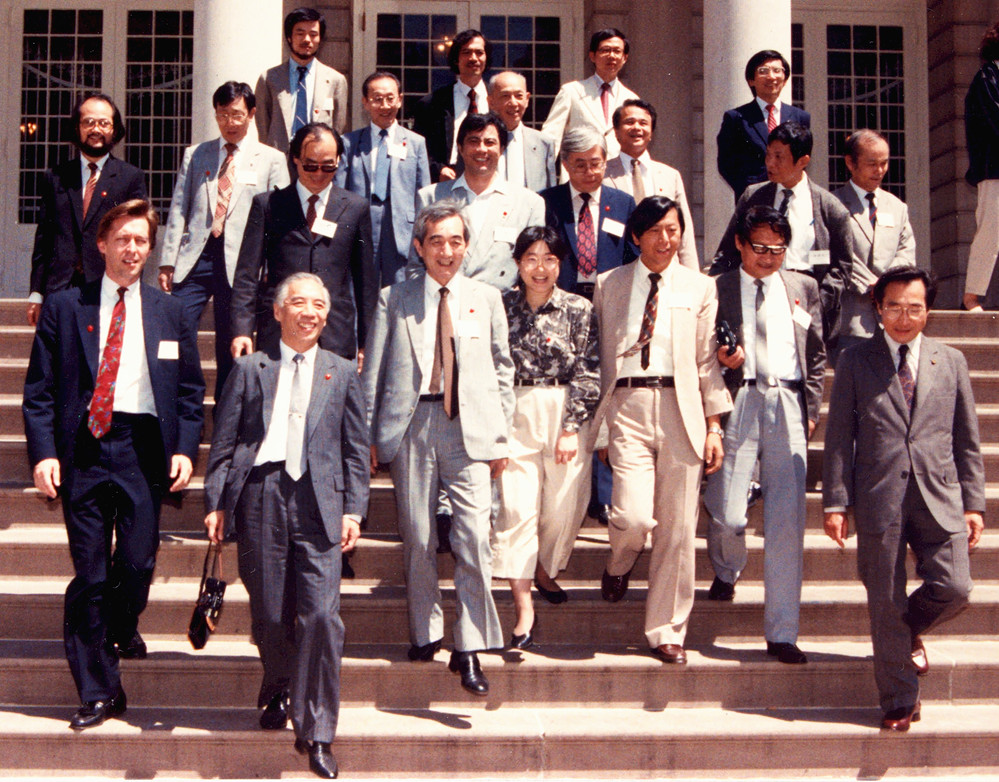 |
|
| |
在中国现代作曲家大会在美国召开期间,与会人员合影
,在这里看到很熟悉的身影,我的老师汪立三也在其中(1988) |
|
|
|
| |
1988年8月8日,在与时任纽约市市长爱德华·科赫会面后,中国大陆和台湾的10位作曲家在纽约市政厅前举行了自1949年以来的首次中国作曲家大会。吴祖强教授在前排,周教授在右边。中美艺术交流中心组织了这次会议。(中国大陆10位作曲家之一的陈毅站在中间。) |
|
|
|
| |
Chinese Composers
Conference with 10 composers from Mainland China and 10 composers from
Taiwan for the first time since 1949, in front of NY City Hall on August
8,1988 following a meeting with then NYC Mayor Edward I. Koch. Prof. Wu
Zuqiang is in the front row and Prof. Chou is on the right. The Center
for US-China Arts Exchange organized the conference. (Chen Yi, who was
one of the 10 composers from Mainland China chosen to participate, is in
the middle.) |
|
|
|
| |
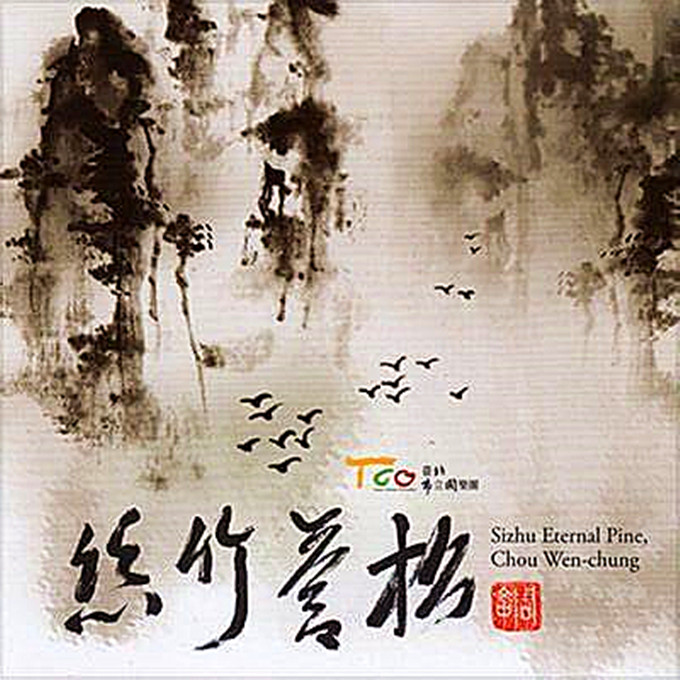 |
|
|
|
| |
周文中(Chou Wen-chung
)的作品唱片封面 |
|
|
|
| |
曾经在哥伦比亚大学求学的作曲家陈怡回忆周文中教授 |
|
|
|
| |
记得上世纪80年代初,我在北京中央音乐学院学习作曲时,有一次在图书馆介绍新引进的音乐唱片时,我意外地听到了周文仲教授对小号与管乐合奏比丘尼自言自语的录音。我跳起来了!虽然它不是中国的民歌风格,但它给我的印象是如此的中国!那动人的音色背后的中国精神给我留下了深刻的印象。当时的中国乐曲在旋律写作中大多采用五声音阶,同时采用西方的和声和形式设计,但这首曲子并不是基于纯粹的五声音阶。我跑过去拿了LP唱片,看到了他的照片。我意识到他一定是在中国出生的,我对这位华裔美国作曲家的音乐感到非常兴奋。这是我第一次听到这个名字——周文忠!我发现周教授在20世纪70年代末作为美国驻华代表参与了此事。他向中国音乐学院捐赠了许多乐谱、唱片、书籍和其他材料。在图书管理员将所有这些资料编目后,学生们可以从一系列新的进口录音广播节目中学习这些资料。就在那时,我们被介绍给周文仲的音乐。
在他参观中央音乐学院时,我有幸听了他的讲座。他的公开讲座由音乐系主持,有许多音乐系和作曲系的教授和学生参加。除了介绍当代美国作曲家及其音乐外,周教授还回答了许多有关美国大学音乐教育的问题。后来我们得知他在纽约市的哥伦比亚大学任教。
周教授对我的影响,最重要的不仅仅是运用基本的作曲技巧来创作音乐,更重要的是对中西方文化的深入研究,为我获得控制和发展音乐元素的创意理念和方法提供了灵感。其结果在我们的语言中是独一无二的。周教授结合东西方风格和技巧的作曲概念给了我很多启发。在哥伦比亚大学的早期,当周教授的作品在中国大陆和台湾播放时,我也将他的许多作品的节目单翻译成中文。我喜欢这样做,因为周教授的笔记非常诗意和漂亮用英语写,你必须集中注意力很难在中国找到如何正确说这些事情,在某种程度上,保持美丽的文学人物,不会让他们坦诚,直接背诵的事实。
|
|
|
|
| |
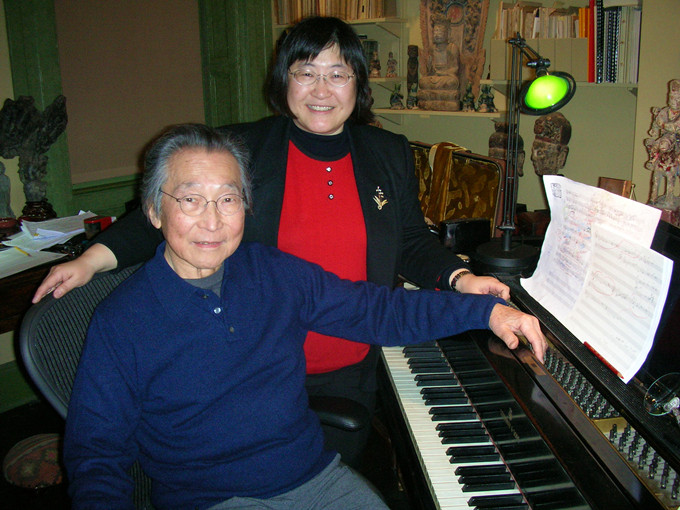 |
|
|
|
| |
作曲家陈怡回忆留学后的恩师感慨万千。 |
|
|
|
| |
Chen Yi, a composer
who graduated from the Central Conservatory of Music, recalls
his mentor's emotion after studying abroad. |
|
|
|
| |
Remembering when I studied composition at the
Central Conservatory in Beijing in the early 80s, once in a
lecture given at the library, to introduce newly imported music
recordings, I surprisingly heard a recording of Prof. Chou
Wen-chung’s Soliloquy of a Bhiksuni for trumpet and wind
ensemble. I just jumped up! Even though it wasn’t in Chinese
folk-music style, it struck me as so Chinese! I was deeply
impressed by the Chinese spirits hidden behind the striking
sonorities. At that time, most Chinese compositions used
pentatonic scales in melodic writing while using Western harmony
and formal designs, but this piece was not based on pure
pentatonic scales. I ran and got the LP recording and I saw his
photograph. I realized then that he must have been born in
China, and I was very excited by this Chinese-American
composer’s music. This is the first time I heard the name — Chou
Wen-chung! I discovered that Prof. Chou was involved as a US
delegate to China in the late 1970s. He donated many scores,
recordings, books, and other materials to Chinese
conservatories. After the librarians had catalogued all of these
materials, they were made available to students for study from a
series of new imported record broadcasting sessions. It was at
that point we were introduced to Chou Wen-chung’s music.
I was also lucky enough to have attended his lecture when he
visited the Central Conservatory. His public lecture was hosted
by the Musicology Department, and attended by many professors
and some students in the Musicology and Composition Departments.
Besides introducing contemporary American composers and their
music, Prof. Chou also answered many questions about music
education in American universities. We then learned that he
taught at Columbia University in New York City.
The most important impact of Prof. Chou’s influence on me was
not only to use basic composition techniques to write music, but
the in-depth study of both Chinese and Western cultures, which
would provide inspiration for getting creative concepts and
methods for controlling and developing musical elements. The
outcome would be unique, in our own language. Prof. Chou
inspired me a lot with compositional concepts that unite Eastern
and Western styles and techniques. In our early years at
Columbia, I also translated many program notes of Prof. Chou’s
compositions into Chinese, when his works were being played in
Mainland China and Taiwan. I enjoyed doing that because Prof.
Chou’s notes are so poetic and beautifully written in English
that you have to concentrate hard to find how to say these
things correctly in Chinese, in a way that will keep their
beautiful literary character and not make them just a frank,
straight reciting of facts. |
|
|
|
| |
|
|
|
|
| |
|
|
|
|
| |
【周文中】【仅音频】变,为钢琴、十件木管和四位打击乐 Pien, For Piano, 10 Winds And Four
Percussionists |
|
|
|
| |
周文中:室内协奏曲《变》
(Chou Wen-chung; “pien”,Chamber Concer for piano,Wnnds and
Percussio,l966)
“变”,周文中写道,在哲学上,“变”是“易”这一术语的同义词,它来自《易经》。从一种意义来说,它指的是复杂的事物是由简单的事物发展而来的,从另一种意义来说,是指表面现象产生于复杂的事物;还有一种意义,乃是现象的聚合与分离;最后则是指恒定不变。
这个作品由六种“变”的方式所构成,这些变化则由连续小三度所组成。每个变化的方式在自己的范围内又不停地产生变异。钢琴和管乐在平等的关系上被当作两种独立的实体。打击乐则穿插于两者之间,用来增强钢琴的作用并与管乐呼应。 |
|
|
|
| |
“pien”
zhou wrote, is philosophically synonymous with the term "yi,"
which comes from the Book of Changes.In one sense, it means that
complex things develop from simple things. In another sense, it
means that surface phenomena arise from complex things;Another
is the convergence and separation of phenomena;And finally,
constant.
This work consists of six ways of "changing", and these changes
consist of a continuous small third.Each mode of change is
constantly mutating in its own territory.Piano and wind are
treated as two separate entities in an equal
relationship.Percussion is interspersed between the two to
enhance the role of the piano and to respond to the wind. |
|
|
|
| |
|
|
|
|
| |
|
|
|
|
| |
周文中Chou
Wen-chung:纪录片:音乐的汇流 Composer of Confluence。 |
|
|
|
| |
周文中先生为世界著名作曲家、教育家及社会活动家,对中国当代音乐创作、音乐教育、文化传播之建设具有深刻的历史影响。2018年,星海音乐学院遵循先生意愿,成立“周文中音乐研究中心”。
这部由Michelle Vosper与李消非合作制作的影片在研究中心成立仪式上公演。 |
|
|
|
| |
As a
world famous composer, educator and social activist,
Mr. Zhou Wenzhong has a profound historical
influence on the construction of contemporary Music
creation, music education and cultural communication
in China.In 2018, Xinghai Conservatory of Music set
up zhou Wenzhong Music Research Center in accordance
with Mr. Zhou's wishes.The film, produced by
Michelle Vosper and Lee, premiered at the
institute's launch. |
|
|
|
| |
|
|
|
|
| |
未得原作者编者授权严禁转载www.mt77.com任何内容 |
|
|
|
|
|
|
|
|
|
|
|
|
|
|


